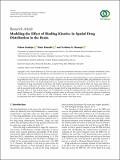| dc.description.abstract | Brain atrophy is a result of volume loss commonly indicated by brain parenchyma separation
from calvarium on neuroimaging. The prevalence of childhood brain atrophy has not been
determined globally. Despite sporadic reports, surprisingly little is known about the prevalence,
risk factors, and functional effects, except in children's brains associated with epilepsy. There is
currently no published alternative to high-priced automated technologies for reproducible manual
quantification of brain volume. The primary aim of the study was to develop a manual diagonal
brain fraction (DBF) formula for quantifying and grading brain volume to evaluate the effects of
brain atrophy among children in the selected East African Countries-Northern Tanzania and
Rwanda. Children in Northern Tanzania and Rwanda were analysed for evidence of brain atrophy
using one-dimension linear radiological techniques and a newly developed formula, revealing a
prevalence of 14.06% and 22% respectively. There were four distinct grades of disease severity.
Head trauma, neonatal hypoxia, central nervous system infections, and increased intracranial
pressure were cited as potential inducers of the atrophy. Significant alterations in brain waves were
observed using EEG, which proved the altered functional implications of brain atrophy. These
included, for example, decreased Delta/Alpha ratios (DAR) and higher beta activity. There is a
negative relation between brain volume and IQ test scores in atrophied brain. Brain atrophy was
also found to be strongly related to the presence of convulsive disorders. The results of this study
conclude that, childhood brain atrophy is quite widespread among the population that was studied.
The DBF is a straightforward technique for evaluating overall brain volume. Possible risks of brain
atrophy in children include birth injury, central nervous system infection, head trauma and
increased intracranial pressure. Beta activities such as Beta/Alpha ratio (BAR) may serve as brain
atrophy bio-markers while the Delta/Alpha ratio (DAR) is trivial in brain atrophy settings. Damage
to the brain's neurocognitive functions is reflected by lower-than-average IQ percentile score for
age in atrophied brains. As a result, it is critical to develop methods of protecting children's mental
health from potential risks. | en_US |



